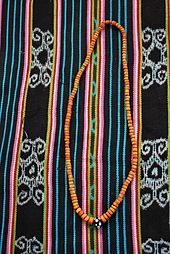Mutissala

A Mutissala (also Muti Salak , Muti Salah or Anahida , in Makasae Gaba ) is a traditional necklace used in the east of the Lesser Sunda Islands on the islands of Timor , Roti , Sawu and Sumba . They are also known on other islands in eastern Indonesia . They consist of orange to dark red stones of the precious coral , which are called mortar , and sometimes have the equivalent of several cattle.
In 1674 the entire crew of a stranded Dutch ship in the kingdom of Dimu , on the island of Sawu, was massacred. As a result, a punitive expedition was sent against Dimu the following year from the base of the Dutch East India Company (VOC) in Kupang (Timor). However, the fortress of Hurati could not be taken, so they agreed on a ceasefire and compensation. In addition to 240 slaves and gold, the compensation payment also included mutissalas.
The necklaces were probably used as a commodity by Indian, Malay and Chinese traders who traded them on the islands for sandalwood and beeswax together with glass beads, white linen cloth, knives, machetes, bowls and plates . Before that, the locals pulled seeds on strings and used them as jewelry.
Mutissalas serve as a traditional prestige object with which one can show one's status, economic efficiency and wealth. So they are part of the family fortune. As so-called Inuh chains, they are regarded by the Atoin Meto as a legacy highly respected by their ancestors and only change hands in exchange between related families. They still serve as the bride price today. They are mostly worn by women, but also by men in traditional costumes for festivities. But also in everyday life, for example, young people in Kupang wear them. In the meantime, there are also many counterfeits from Bali in circulation, some of which are sold for a ridiculous price. Often only experts can distinguish real mutissalas from fake ones, which may not have a high material value, but a historical and cultural value.
Web links
Individual evidence
- ↑ a b TLcultura: Produto Tradisional Iha Timor Leste , accessed on November 26, 2016.
- ↑ Mario Barreto, Simone Michelle Silvestre: Bé-Malai: Mito e Rito presentes na narrativa do Grupo etnolinguístico Kemak, Distrito Bobonaro, em Timor-Leste , accessed on November 26, 2016.
- ↑ a b c d Doan Lontar: Muti Salak, Untaian Mutiara Nusa Tenggara Timur , June 30, 2013 , accessed on November 26, 2016.
- ↑ Heidrun and Herbert W. Jardner : Captured threads - Textile decorative techniques in West Timor, Indonesia. Part 1: Subject, material, devices , accessed on November 26, 2016.
